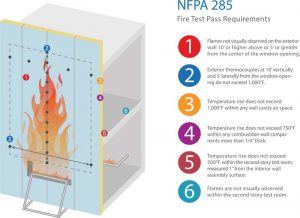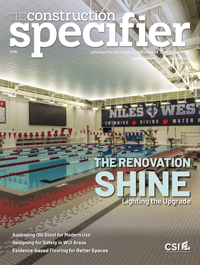Where to find compliant NFPA 285 test data

Using NFPA 285 test data for real-world project designs
Engineering analysis is the most practical and effective way to extend and apply NFPA 285 test and design data to real-world wall assemblies. As noted previously, NFPA 285 tests are typically performed on specimens that are purposely designed as a worst-case condition to allow for subsequent engineering analysis and extension. These analyses take an NFPA 285 tested and compliant wall assembly and compare it against a similar real-world wall assembly to determine if it complies with NFPA 285.
An engineering analysis will usually include a reference to the applicable NFPA 285 test and details of the tested assembly materials and configuration. It should also include clear and detailed discussion of the deviation(s) from the tested assembly and, as appropriate, why each deviation and the combined deviations from the tested assembly will not result in an assembly that no longer complies with NFPA 285. Finally, if necessary and appropriate, the analysis should include drawings to help clarify configuration details.
Two other articles with additional information regarding NFPA 285 engineering analyses include: NFPA 285—Extending Data with Comparative Engineering Analysis (IIBEC Interface, March 2021), and NFPA 285 Engineering Judgements:
A Practical Compliance Option (The Construction Specifier, June 2021).
Designers and specifiers may wish to become familiar with the 2023 edition of the NFPA 285 standard which added significant information and guidance for extending NFPA 285 test results. The guidance is found in Annex B–Guide for Extensions of Results from Assemblies that Meet NFPA 285. The Annex was developed to collect industry experience and useful practices from industry and fire experts. Development of Annex B was also intended to help improve the transparency and understanding of these analyses, including their limitations, through specific guidance for many common considerations, such as changing base walls, changes to insulation, water-resistive barrier and exterior cladding considerations, stud thickness and spacing, and many others.
Notes
1 Refer to ISO 17065, Conformity assessment—Requirements for bodies certifying products, processes, and services.
Author
 In 2022, after more than 14 years in advocacy for the Dow Chemical and Dupont building and construction businesses, Amy Schmidt joined the American Chemistry Council (ACC) as director of building and construction for the plastics division durable materials team. She also leads two industry associations: the Foam Sheathing Committee (FSC) and North American Modern Building Alliance (NAMBA). These teams support the safe and effective use of durable plastic building materials in resilient high-performance applications. Schmidt, who holds a Bachelor of Business Administration from Northwood University and is certified as a LEED Green Associate, also serves on ASHRAE 90.1 main and envelope subcommittees and the International Code Council’s (ICC’s) International Energy Conservation Code Residential Main and Residential Envelope Subcommittees.
In 2022, after more than 14 years in advocacy for the Dow Chemical and Dupont building and construction businesses, Amy Schmidt joined the American Chemistry Council (ACC) as director of building and construction for the plastics division durable materials team. She also leads two industry associations: the Foam Sheathing Committee (FSC) and North American Modern Building Alliance (NAMBA). These teams support the safe and effective use of durable plastic building materials in resilient high-performance applications. Schmidt, who holds a Bachelor of Business Administration from Northwood University and is certified as a LEED Green Associate, also serves on ASHRAE 90.1 main and envelope subcommittees and the International Code Council’s (ICC’s) International Energy Conservation Code Residential Main and Residential Envelope Subcommittees.
 Eric W. Banks is a technical consultant specializing in the development, physical and fire testing, certification, and codes and standards compliance of building products and their applications with
Eric W. Banks is a technical consultant specializing in the development, physical and fire testing, certification, and codes and standards compliance of building products and their applications with



